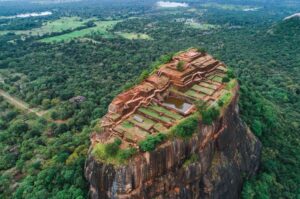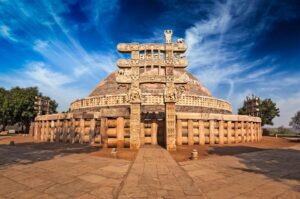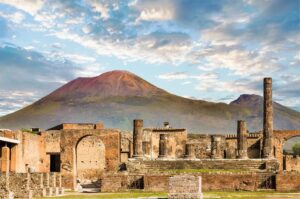Founded, flourishing, and ultimately forgotten – this has been the fate of many cities since ancient times. A few names have remained alive in legend and literature while others have vanished altogether – until a chance discovery brings these mysterious metropolises back from the dead. From Sigiriya, the incredible hilltop site in Sri Lanka, to the amazing Pompeii in Italy, we take a look at some of the most fabulous lost and reborn cities and how to visit, when it is safe to do so.
Sigiriya, Sri Lanka
The jungle of central Sri Lanka is thick and lush. In 1831, Major Jonathan Forbes of the 78th Highlanders of the British Army was struggling to navigate his way on horseback. But as he emerged, he came across an astonishing sight. It was the “bush-covered summit of Sigiriya” adorned with brightly colored frescoes that appeared to have been painted. Forbes had rediscovered a mythical city abandoned since the 14th century.

Sigiriya means lion and the city is preceded by a huge lion entrance – unfortunately its head is missing. Sigiriya was built on a rocky outcrop 200m above the jungle, initially as a Buddhist monastery in the 3rd century BC. Then 800 years later, King Kasyapa built a sumptuous palace there and covered it with frescoes. The palace was surrounded by gardens, swimming pools, and a wall of mirrors so shining that the king could see his face.
Sigiriya means lion and the city is preceded by a huge lion entrance – unfortunately its head is missing. Sigiriya was built on a rocky outcrop 200m above the jungle, initially as a Buddhist monastery in the 3rd century BC. Then 800 years later, King Kasyapa built a sumptuous palace there and covered it with frescoes. The palace was surrounded by gardens, swimming pools, and a wall of mirrors so shining that the king could see his face.
It takes about an hour to climb the 1,200 steps to the top of the rock, but the hike is rewarded with the view of the Sky Palace surrounded by beautiful gardens, pools, and moats as well as colorful frescoes. Called by some the eighth wonder of the world, UNESCO recognized Sigirya as a World Heritage Site in 1982.
Sanchi, India
In 1818, Major Henry Taylor and his men were hunting a two-day march northeast of Bhopal in central India. They came across a huge dome-shaped stone structure with several stone walkways. Each was 12 m high and 2.7 m wide and was decorated with carvings of elephants, horses, lions and young girls.

Taylor had discovered a Buddhist complex from the 3rd century BC. AD built by Emperor Ashoka. At the time, Buddhism was relatively unknown, but Ashoka was drawn to its message of peace. He built a large dome-shaped stupa or temple guarded by four doors carved with scenes from Buddhism. However, in the 13th century AD, the center was abandoned.
Sanchi can usually be reached by bus or car from Bhopal Airport. The preservation of the site is amazing and visitors can admire the Grand Stupa, one of three such structures, along with 50 other monuments and a monastery. In 1989, Sanchi was named a UNESCO World Heritage Site.
Pompeii, Italy
In 1748, the Duke of Naples had a summer palace built 24 km south of Naples, on the west coast of Italy. As workers were digging foundations, they encountered the buildings and streets of a lost city, and treasure hunters and art collectors descended on the scene. He realized to people that this was the lost and largely forgotten Roman city of Pompeii – destroyed by the eruption of Vesuvius one day in the summer of AD 79.

Throughout the Victorian era when this photo was taken, people flocked to see the mysterious city as more were discovered. They found a huge amphitheater, a forum and beautiful villas as well as ordinary houses, streets, shops and brothels. On the day of the eruption, thousands of people were trapped and died of gas poisoning. Their bodies left cavities in the ash and when the plaster of Paris was poured their sad remains became evident.
Pompeii is generally one of the most visited tourist attractions in the world – 2.5 million went there in 2018. It’s amazing to see this world trapped in time with the colors of the murals as fresh as if they came from to be made. And excavations continue, with much of the city yet to be discovered and surprising secrets still unveiled. This city became a UNESCO World Heritage Site in 1997.


